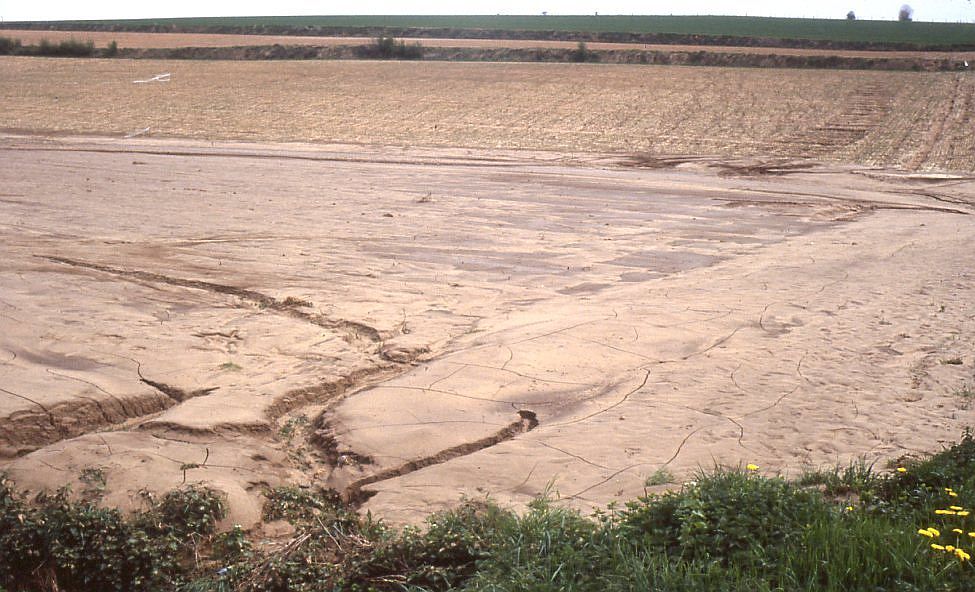
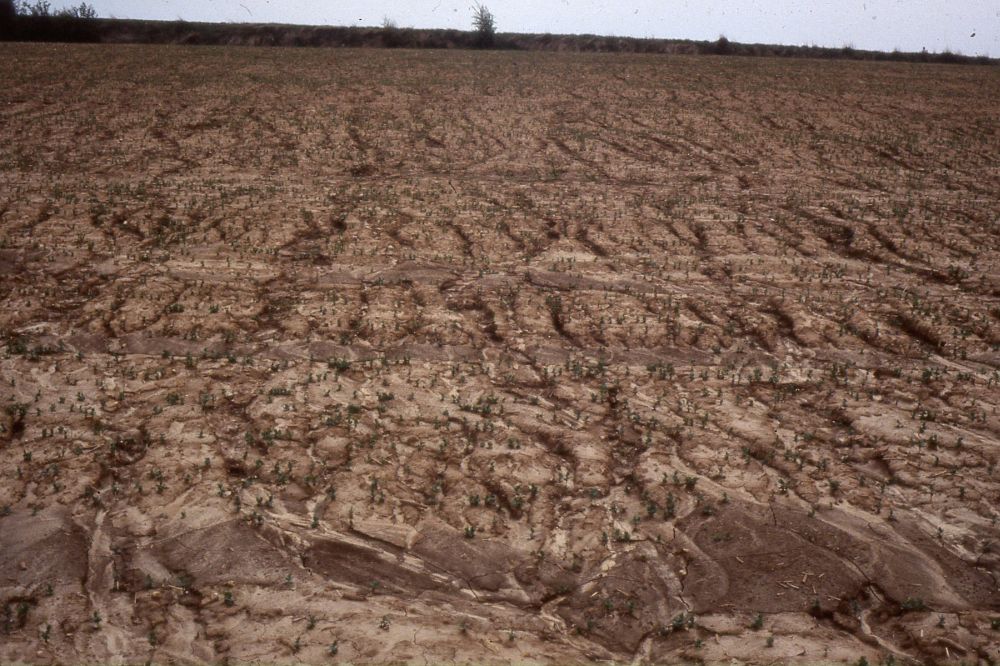
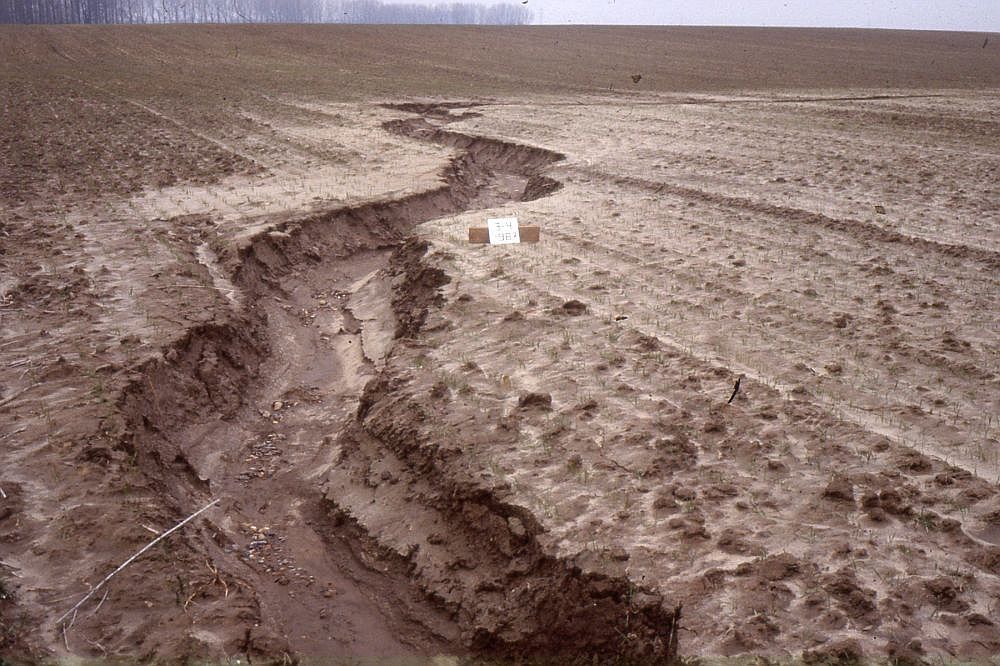
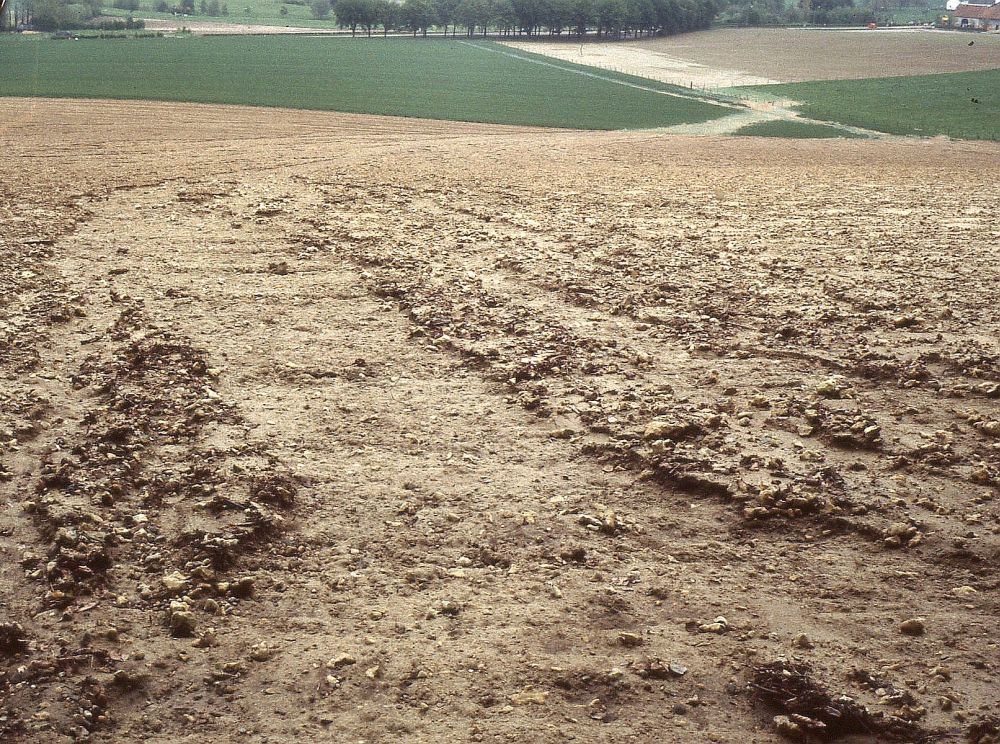
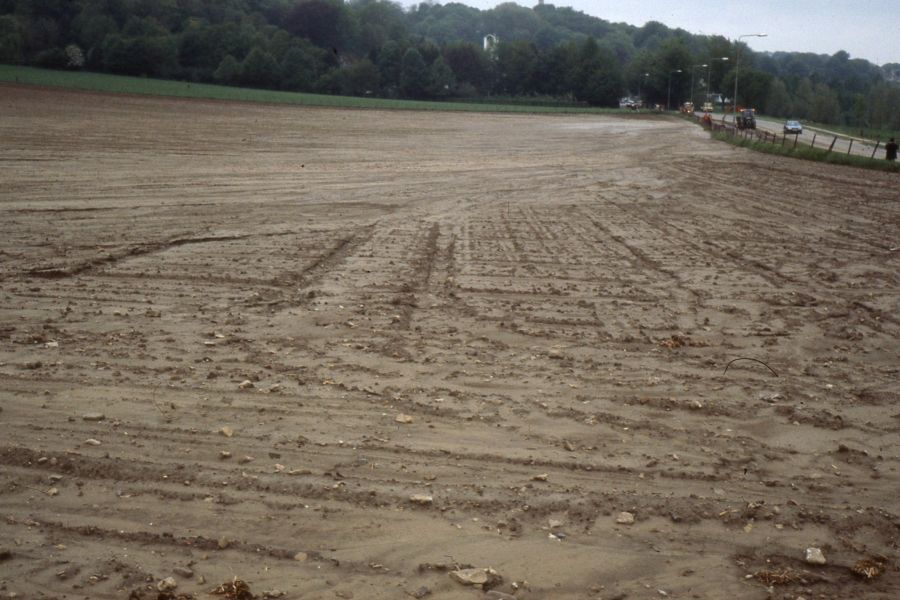
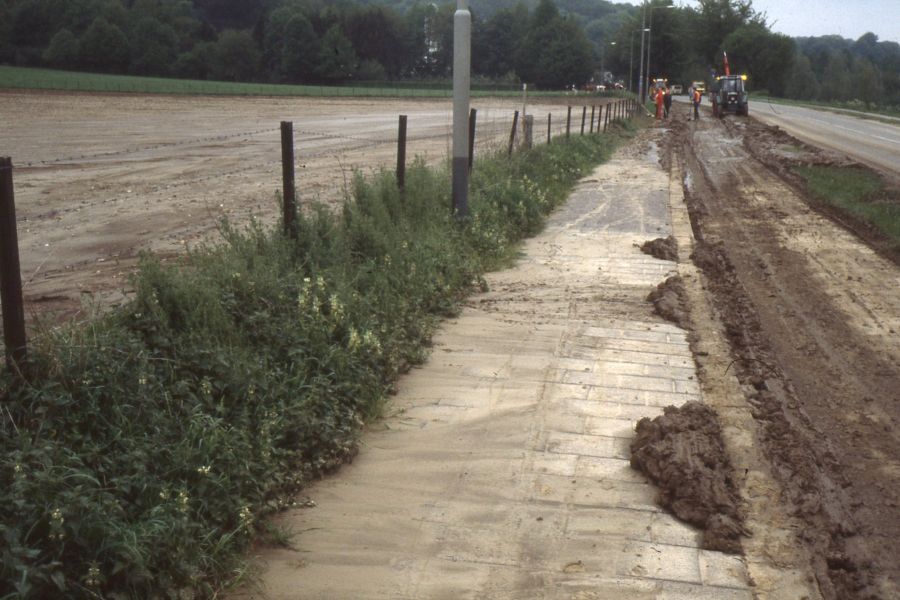
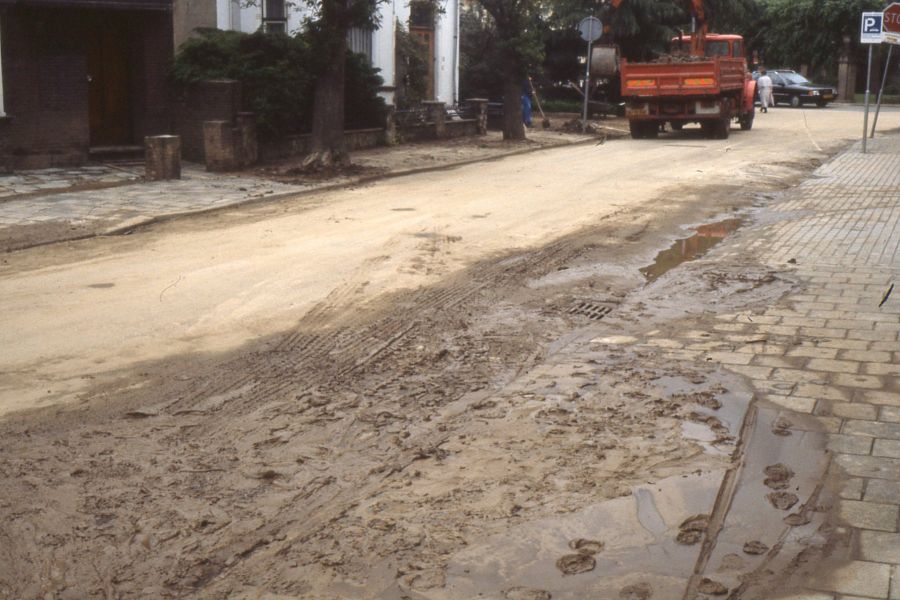
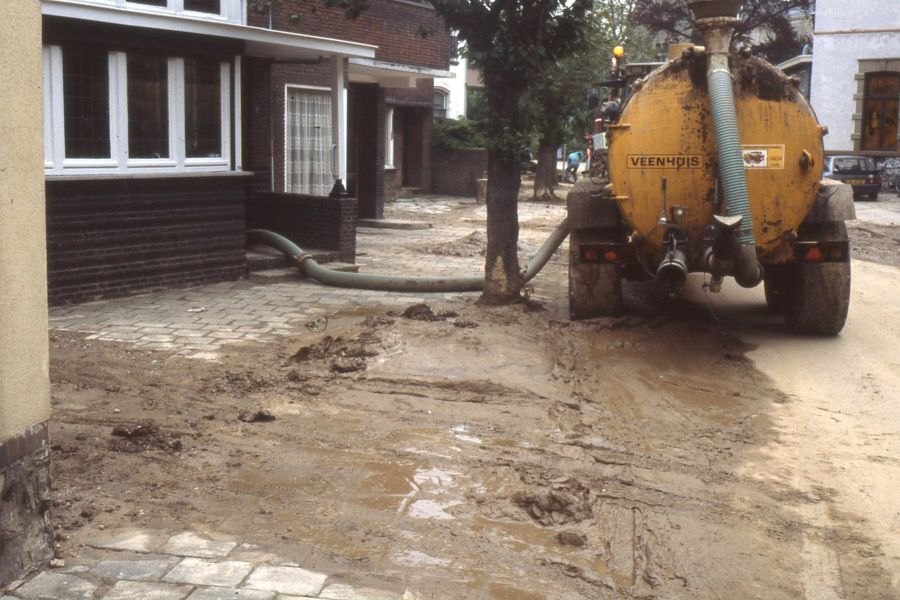
Mud in a street of the town of Valkenburg and pumping of a cellar after a soil erosion event (photo F. Kwaad).
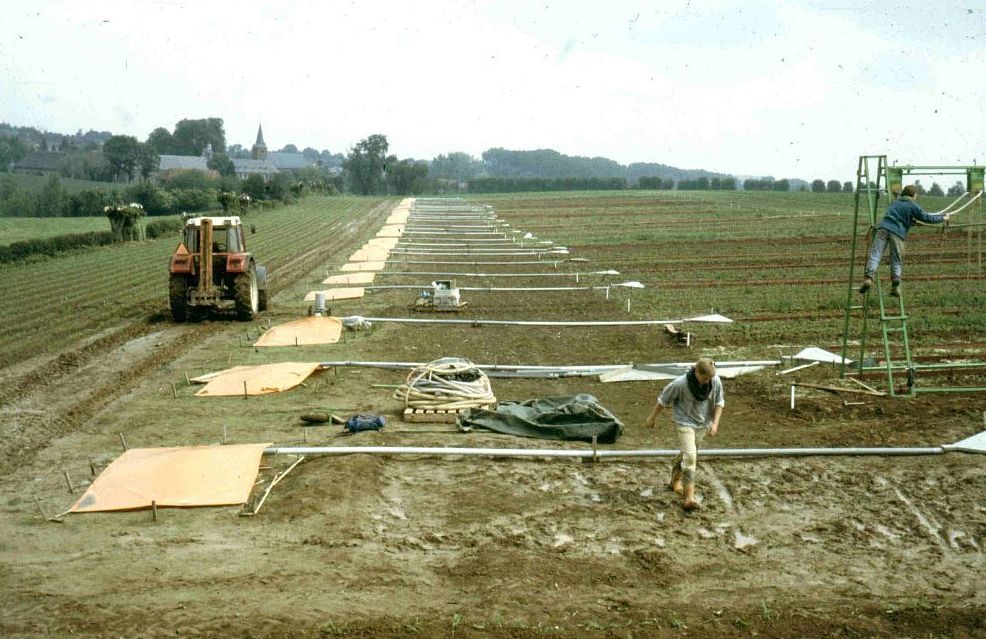
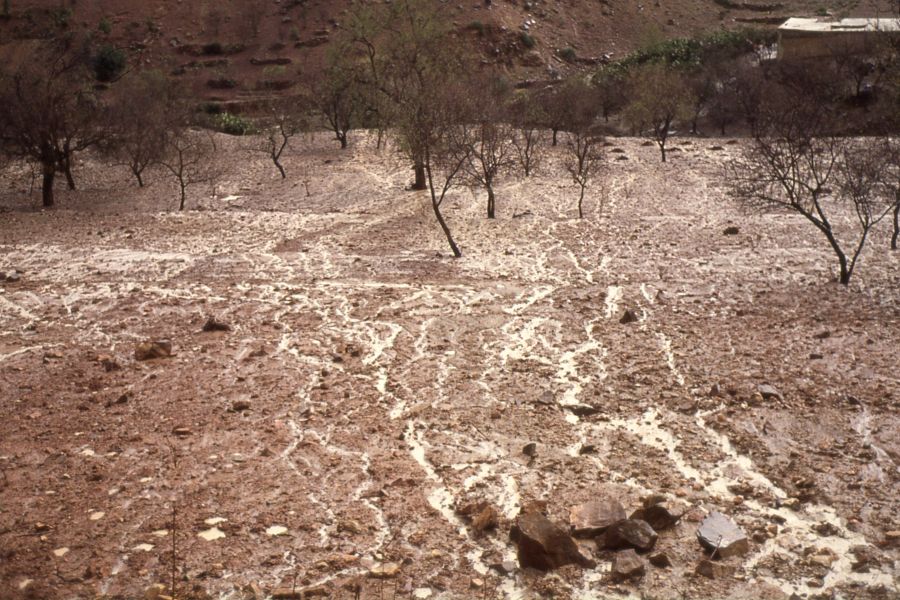
Rill erosion going on during a rainstorm on bare arable land (barley and almond trees) in the Rif Mountains, Morocco (photo F. Kwaad).
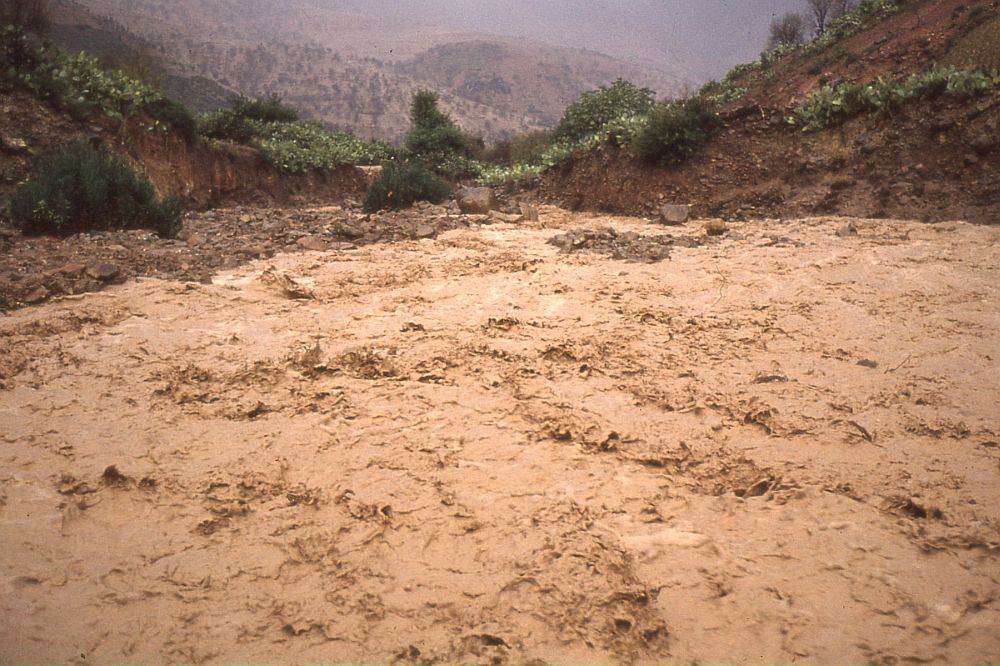
Sediment laden water during a heavy rainstorm. The oued was dry before the storm, Rif Mountains, Morocco (photo F. Kwaad).

Road crossing a dry oued, blocked by debris after a soil erosion event, just downstream of the picture above, Rif Mountains, Morocco (photo F. Kwaad).
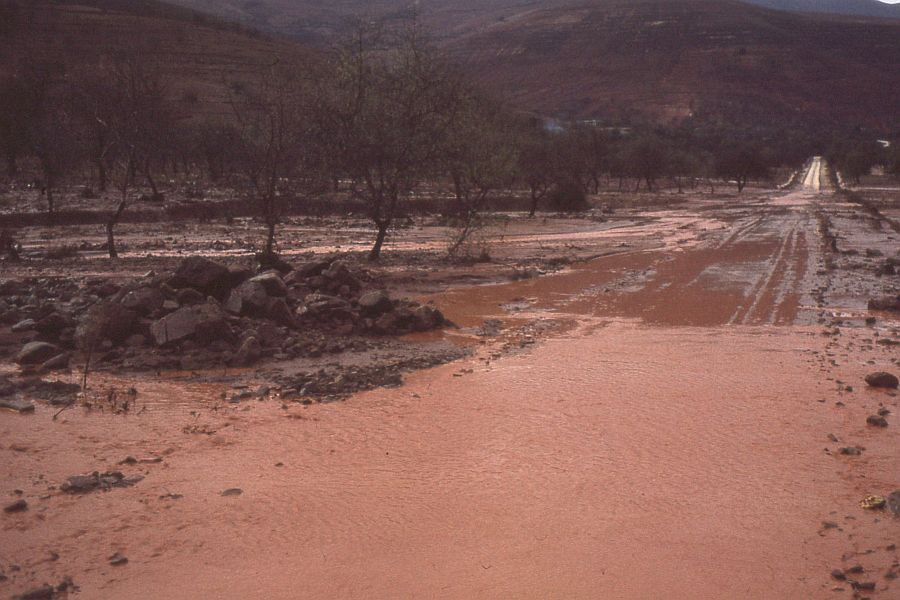
Road along the main oued covered with mud after the same soil erosion event as above, Rif Mountains, Morocco (photo F. Kwaad).
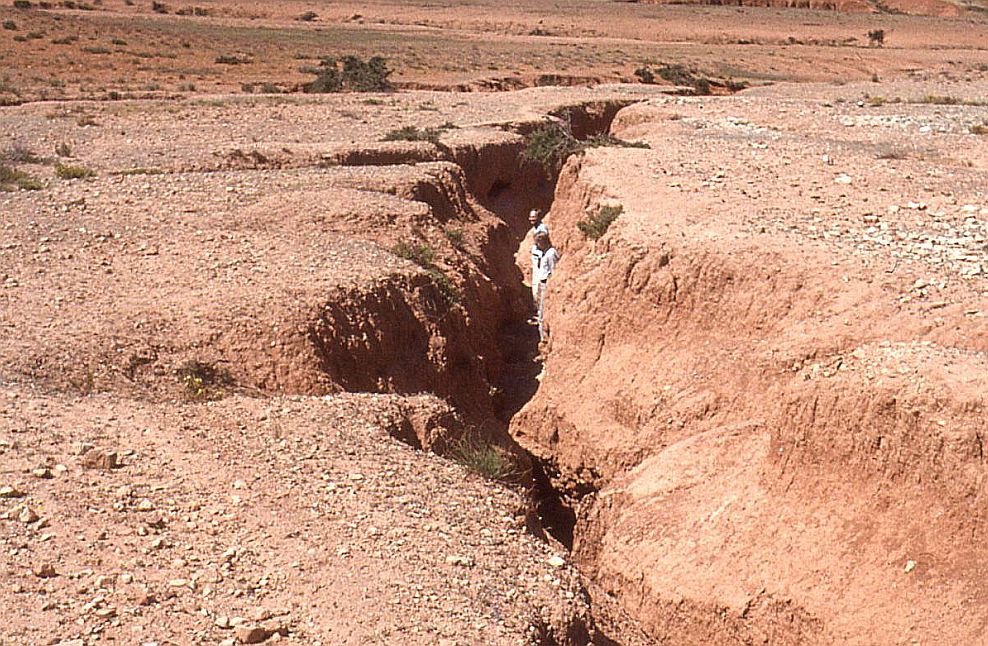
Over 2 m deep gully, Rif Mountains, Morocco (photo F. Kwaad)
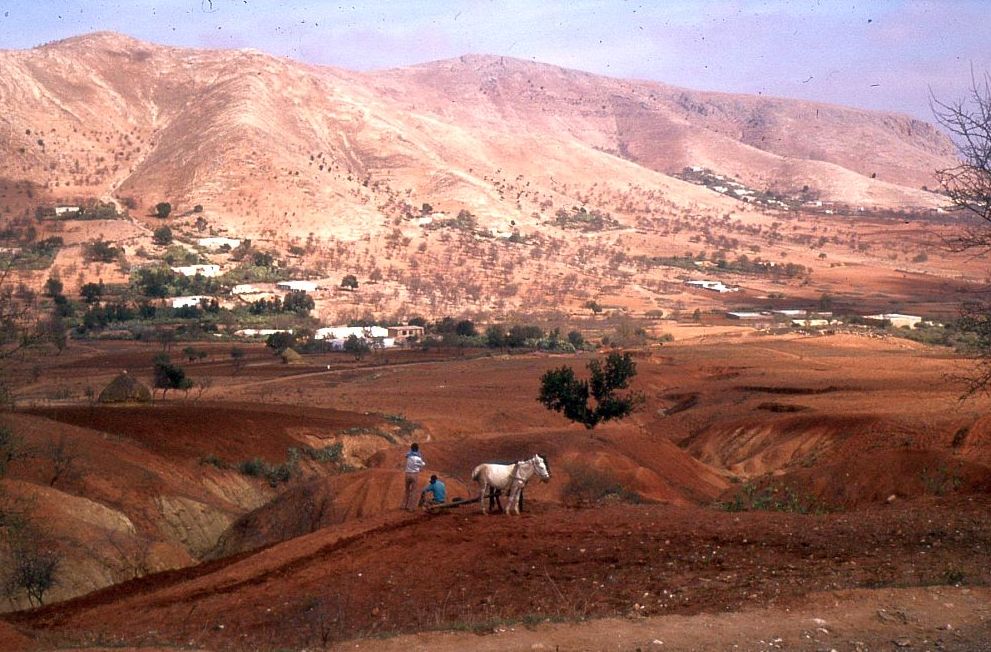
Hills eroded to bedrock and gullies incised in valley-infill material, Rif Mountains, Morocco (photo F. Kwaad).
Economic costs of soil erosion
The following questions can be asked related to the economic effects of
soil erosion:
1.
How high is the
decrease in crop yield per cm loss of topsoil depth? Does, in fact,
soil
productivity decrease much further, once the original humus rich
A1-horizon of the natural soil profile is gone, such as is the case in
large parts of Europe with its centuries
old cultural landscapes (provided that sufficient rooting depth
remains)?
2. What is the extent of the offsite damage caused by soil erosion
around the
world? How widespread is it?
3. How high
are the economic costs of soil
erosion around the world today? Is there a trend
in economic costs visible over the past hundred years?
4. How much does it
cost farmers to
apply soil erosion control measures on their farms?
5. On
how many acres of cultivated land around the world soil erosion control
measures are practiced today, and has this led to a reduction of the
onsite and offsite effects and related economic costs of soil
erosion?
Quantitative data to answer these
questions are scarce.
A preliminary question is: How
well do we really know the rate of soil erosion? On the measurement of
soil erosion Lal
(2001) remarks:
The
measurement
of
soil
erosion
is
still
more
of
an
art
than
science,
and
a
wide
range
of
techniques
are
used
to
monitor
soil
erosion.
There
is
a
strong
need
to
standardize
methods
of
measurement
of
soil
erosion
rates
at
field,
hillside
and
watershed
scales.
Fourteen years later Garcia-Ruiz
et
al.
(2015) in their paper "A meta-analysis of soil
erosion rates across the world" still warn that the data obtained have
not been independent of the method used. See also the review paper on
"Natural and anthropogenic rates of soil erosion" by Nearing
et
al
(2017).
Contrary views on the importance
of soil erosion have been expressed by Pimentel (1995, 2006, 2013) and
Crosson (1995, 2000).
Trimble
and
Crosson
(2000):
Soil
erosion
in
the United States has been a matter of public concern since
the 1930s. Conditions were improved by the 1960s, although no one knew
just how much. Starting in the 1970s, however, several studies
concluded that erosion was high. Although a few studies have been
skeptical of these high rates, most have suggested that soil erosion is
an extremely serious environmental problem, if not a crisis.
Quantification of the problem has been elusive, and average annual U.S.
cropland soil erosion losses have been given as 2 billion, 4.0 billion,
4.5 billion, 4.8 billion, 5 billion, or 6.8 billion tons.
The remarkable feature of all this
discussion and attempted rectification is that it was based mostly on
models. Little physical, field-based evidence (other than anecdotal
statements) has been offered to verify the high estimates. It is
questionable whether there has ever been another perceived public
problem for which so much time, effort, and money were spent in light
of so little scientific evidence.
Pimentel and Burgess
(2013):
Since humans worldwide obtain more than 99.7% of their food (calories)
from the land and less than 0.3% from the oceans and aquatic
ecosystems, preserving cropland and maintaining soil fertility should
be of the highest importance to human welfare. Soil erosion is one of
the most serious threats facing world food production. Each
year about 10 million ha of cropland are lost due to soil erosion, thus
reducing the cropland available for world food production. The loss of
cropland is a serious problem because the World Health Organization and
the Food and Agricultural Organization report that two-thirds of the
world population is malnourished. Overall, soil is being lost from
agricultural areas 10 to 40 times faster than the rate of soil
formation imperiling humanity’s food security.
Regarding the first of the five
questions above Bakker
et
al.
(2005) write as follows:
Although
the
problem
has
received
much
attention
recently,
hardly
any
quantitative
information
on
the
effect
of
erosion
on
agricultural
productivity
exists.
The
quantitative
information
derived
at
the
plot
scale
is
scattered
and
incoherent,
and
no
quantitative
information
at
the
regional
or
national
level
(i.e.
the
level
relevant
for
food
production)
exists.
Inferences
made
from
the
synchronicity
of
soil
erosion
events
and
societal
changes
are
therefore
not
based
on
quantitative
assessments
of
the
impact
of
soil
erosion
on
agricultural
productivity,
nor
are
analogies
between
the
collapse
of
an-cient
societies
and
the
risks
facing
modern
society.
For
this
reason,
the
extent
to
which
soil
erosion
is
indeed
a
significant
threat
to
the
agricultural
productivity
of
modern societies is an important
subject for debate.
The research presented here reports of
statistical analysis of both
plot and regional scale with respect to the erosion-productivity
relationship. A meta-analysis of plot scale experiments shows that the
different methodologies used for the erosion-productivity assessments
bear part of the responsibility for the incoherence of the outcomes.At
the plot scale, the effect of soil
erosion on crop growth has been assessed in numerous experiments where
erosion was either simulated by artificial desurfacing, or where
productivity losses in strongly eroded areas were compared with losses
from less eroded areas. A systematic overestimation of the effects may
apply to the first category of experiments, which make up a large part
of the research results. Correcting for this overestimation reveals
that under intensive,
mechanized agriculture yield reductions at the
field scale are of the order of only 4% for each 0.1 m of soil loss.
Given the fact that the removal of 0.1 m of soil required either long
time-spans, or very high erosion rates, this number makes it highly
unlikely that erosion may pose a serious threat to food production in
modern societies within the coming centuries. An empirical
analysis of
the relationship between erosion and productivity for modern
agriculture at the regional scale, also shows no agreement with
previous assumptions concerning the importance of the impact of erosion
on agricultural productivity either. The results of this analysis
converge with the corrected plot-scale findings of approx-imately 4%
per 0.1 m of soil loss. (underscored
by
FK)
The most comprehensive study of the impact of soil erosion on crop
productivity is Den
Biggelaar
et
al.
(Parts
1
and
2,
2004).
They start by remarking:
Despite
millions
of
dollars
invested
in
erosion
research,
it
is
difficult
to
state
precisely
what
effect
the
loss
of
a
unit
of
soil
has
on
crop
yield
(Lal,
1987a).
This
is
due
in
part,
as
Perrens
and
Trustum
(1984)
and
Erenstein
(1999)
observed,
to
the
fact
that
there
is
no
direct,
clear-cut
relationship
between
erosion
and
productivity,
making
the
assessment
of
the
impact
of
erosion
on
productivity
difficult.
Productivity
decline
may
not
relate
directly
to
the
amount
of
soil
loss
(expressed
in
Mg
or
cm
ha
21
yr
21
),
but
may
be
a
result
of
erosion-induced
changes
in
the
physical,
chemical,
and
biological
qualities
of
soil
that
influence
production
(e.g.,
water
holding capacity, soil organic matter (SOM) and nutrient
contents, and bulk density). Moreover, soil is only one of the factors
affecting productivity, as crop yield is a function of many variables.
One
of the conclusions of
Part 1 (p. 36) is:
The
results
of
the
present
analysis
show
that
average
crop
yields
and
effects
of
past
erosion
on
yields
(measured
in
Mg
yield
decline
per
cm
of
erosion)
differ
greatly
by
crop,
continent
and
soil
order.
However,
aggregated
across
soils
on
the
continental
level,
differences
in
productivity
declines
per
Mg
of
soil
erosion
are
fairly
small.
The
absolute
yield
loss
ranged
between
-0.49
and
1.44
kg/ha/Mg
of
soil
erosion
for
grain
and
leguminous
crops,
and
0.69
and
127.0
kg/ha/Mg
for
root
crops.
However,
due
to
differences
in
mean
yields,
the
relative
yield
losses
per
Mg
of
soil
erosion
vary
more,
even
though
losses
were
generally
small
(<<
0.1%/Mg
of
soil
erosion).
The
exceptions
to this general rule were studies on potatoes
in North America, in which yields declined by 0.42%/Mg.
In Part 2 (pp. 91-92) Den Biggelaar et
al. conclude:
Three main conclusions can be drawn from
our analyses:
First, estimated annual losses at a global
scale for the crops and continents considered in our analyses are small
relative to the total agricultural production and value of the selected
crops. The losses are likely to be masked over the short term by market
fluctuations, weather, and other environmental perturbations,
diminishing incentives for farmers to adopt conservation practices.
Moreover, erosion’s impacts are cumulative and may cause more serious
losses if it continues unabated over a long period of time.
Second, our estimated global annual losses in
crop yields and production are at the lower end of the range of
previously published estimates of erosion-induced productivity losses
(Lal and Stewart. 1990; Janargin and Smith, 1993; Crosson, 1997; Lal,
1998;Young, 1999). Of more interest, especially for soil conservation
policy is the finding that losses vary widely between crops, soil
orders and regions, and in selected situations can be quite
substantial. In general, though, little is known about these losses for
many important crops in many developing countries.
Third, estimated losses in productivity
are
probably small in relation to offsite impacts (such as sedimentation).
These
findings
underscore
the
importance
of
continued
policy
measures
to
encourage
soil
conservation.
They
also
underscore
the
importance
of
improved
understanding
of
erosion
and
its
impacts
for
these
crops,
soils,
and
regions
where
its
impacts
are
most
severe
or
least
understood.
Finally,
more
precise
estimation
of
actual
losses
due
to
erosion
(as
opposed
to
the
potential
losses
estimated
here)
depends
on
improved
understanding
of
farmers’
optimal
response
in
the
face
of
changing
physical,
market,
and
policy
environments.
Inman
(2006,
p.
16) on the economics of soil erosion in England and Wales:
The
costs borne by society as a consequence of soil erosion are known as
externalities by economists because they are costs which are not taken
into account either by producers or consumers of agricultural goods and
services. When such externalities are not included in prices, they
distort the market by encouraging activities that are costly to society
even if individual (private) benefits are large.
In the agricultural sector, externalities are regarded as having five
characteristics or features: 1) their costs are often neglected; 2)
they often occur with a time lag; 3) they often damage groups whose
interests are not represented; 4) the identity of the producer of the
externality is not always known and; 5) they result in sub-optimal
economic and policy solutions. Whilst it is relatively straight forward
to identify generic externality categories, quantifying many of these
categories in monetary terms is extremely difficult. Firstly, it is
necessary to know the value of nature’s goods and services, and what
happens to these when they are impacted. Secondly, many externalities
are associated with non-market goods. For example, how do we value
soil-water chemical interactions which produce clean water.
The following Table (from Telles, 2011, p. 293) gives estimates of soil erosion costs in dollars per year. The onsite costs were estimated on the basis of the loss of soil, nutrients, organic matter, productivity and yield. Offsite costs were estimated in various ways. However, the main offsite effects are linked to sedimentation. Depending on the methods used to estimate on- and offsite soil erosion costs, the results can be extremely variable. The majority of studies estimate onsite costs, and these studies show an even wider fluctuation in the estimated figures. Moreover, in terms of the breakdown of total erosion costs, offsite costs are higher than onsite costs.
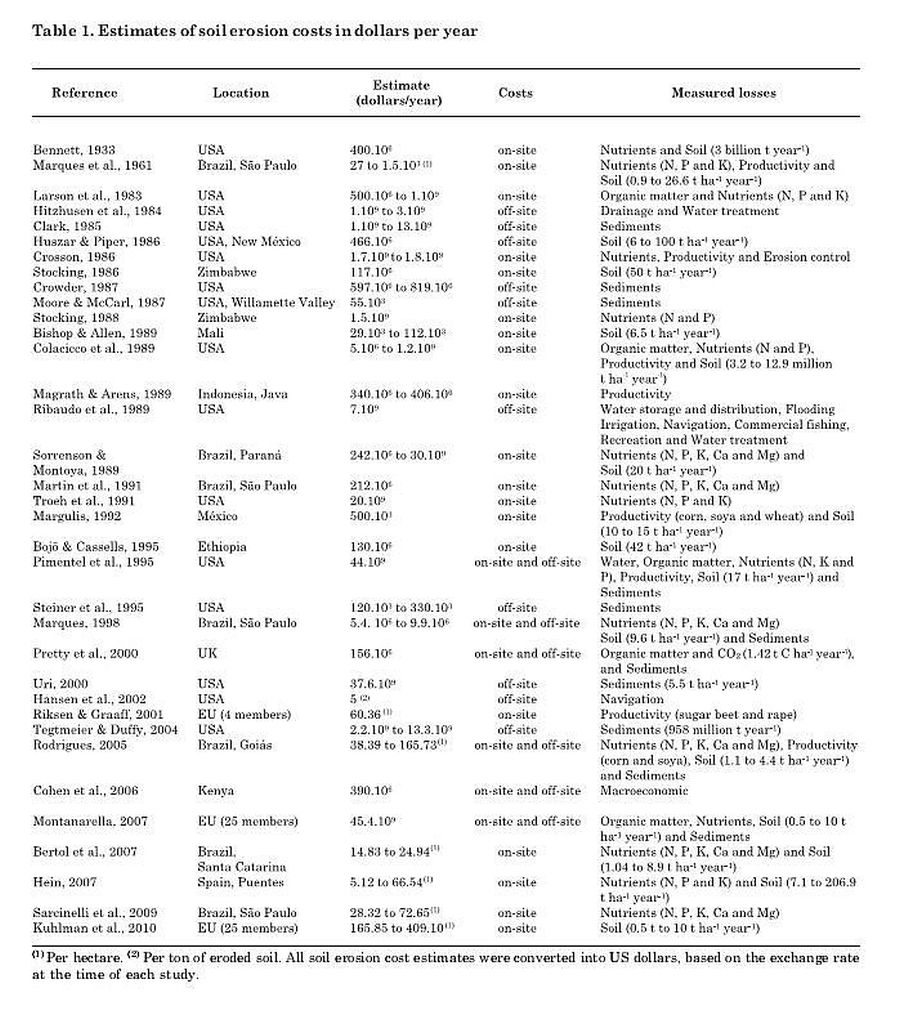
Soil
erosion costs in dollars/year, data assembled from literature by Telles, 2011.
The
following
figure
gives
an
impression
of
the
economic
costs
of
soil
erosion
today:
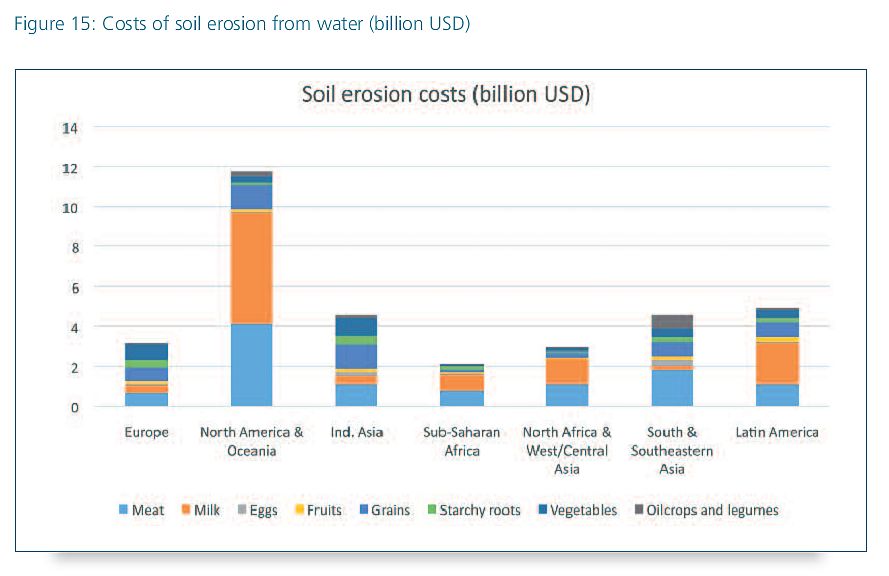
After a flood, the fire brigade and municipal workers clean up public infrastructure and private property (Table 7). Fire brigade interventions cost between 2250 € and 25,000 € per event, while cleaning operations lead to an estimated cost that ranges between 500 € for a single road segment and 11,000 € for a whole village. Several additional repairs to infrastructure may be required, such as unclogging of sewers, local replacement of tarmac or pavements. These works are very costly, ranging between 14,000 € and 300,000 € per event and per municipality. In total, damage to public infrastructure and cleaning induce a global cost of 12.5–122 million €/yr for the entire Belgian loess belt. It must be underlined that the highest costs are only reached after widespread extreme thunderstorms (e.g. August 26–28, 2002, with rainfall depths of more than 100 mm in 24 h in some areas). Damage to houses is also very important, affecting gardens, garages or even the ground floor of the houses. According to the analysis of the Disaster Fund database, mean damage costs reach 4436 € ± 3406 per house. The number of flooded sites with affected houses obtained from the analysis of the regional database (4.2 floods per 100 km2/yr) can be extrapolated to the entire Belgian loess belt (8867 km2 ). Assuming 1 and 10 affected houses per flooded site, damage to private property varies between 1.6 million and 16.5 million €/yr, respectively.
In a follow-up paper (Evrard et al., 2008) it is added:
The Flemish authorities calculated that the construction of all the control measures proposed in the municipal erosion mitigation schemes that were approved by their administration would cost between 7.7– 9.6 million €/yr during the period 2006 – 2025, which is not disproportionate compared with the total damage cost associated with muddy floods in the Flemish municipalities of the Belgian loess belt (between 8 – 86 million €/yr; Evrard et al., 2007a)
Here is another example of the costs and benefits of soil erosion control measures in Belgium:
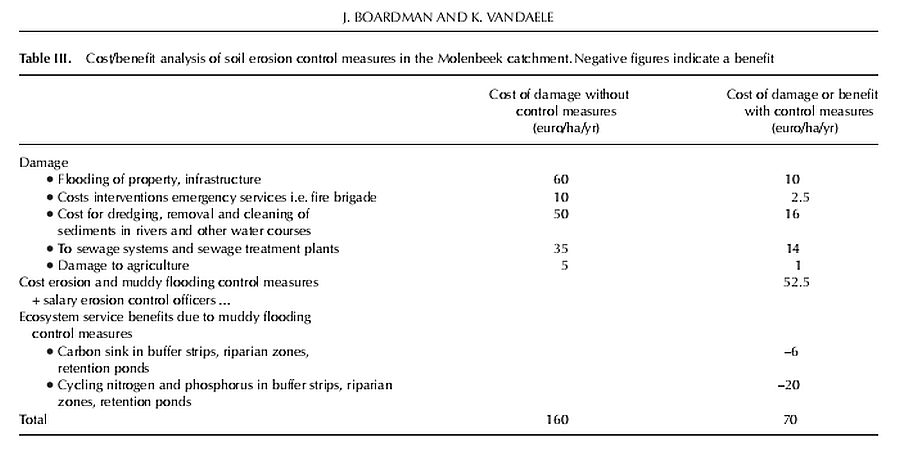
Evans (1995) published data on on- and offsite costs of soil erosion in England and Wales:
Source: based on Evans, 1994 and 1995, 1994 reference refers to 'Report to Friends of the Earth', London, pp.145; published in 1996
On-farm £ million per year
Long-term
Loss in agricultural production 700.0
Loss in value of land 0.04
Short-term
Loss of agricultural inputs and outputs 4.8
Land value of eroded floodplain 3.8
Off-farm
Short-term
Roads and property 3.4
Footpaths 0.98
Stream channels 7.0
Water pollution* 260.0
*Much nitrate probably leaches through the soil rather than being carried off in runoff, and so removal of nitrate from water supplies has been discounted in this estimate of costs
Erosion, especially in the form of gulleys and badlands, is highly visible in the landscape and erosion is the main form of land degradation in the area. However, the local costs of erosion are limited. The most important impact of erosion is on agriculture in the upland parts of the catchment. On annual crops, the costs erosion of erosion vary from less than 4 Euro/ha/y on slopes <10% to 35 Euro/ha/y on slopes exceeding 30%. In almond orchards, erosion costs range form at most 7 Euro/ha/y on slopes <10% to 52 Euro on slopes exceeding 30%. However, all irrigated and most dryland agriculture in the catchment is conducted on slopes of less than 20%. These results explain the lack of interest among farmers in applying erosion control measures. Currently, the only measures applied by farmers are contour ploughing, gulley plugging and maintenance of the terraces. These are all low cost measures, of which the benefits are in line with their costs. The use of more expensive erosion control measures, such as terracing, would not be financially viable from a farmers’ perspective. The study shows that visual impressions of highly eroded landscapes or erosion measurements in selected areas may lead to overestimating the economic impacts of erosion, and that analysing the actual costs of erosion is crucial to understand farmers’ responses to land degradation.
Auerswald, K., Fischer, F.K., Kistler, M., Treisch, M., Maier, H. and Brandhuber, R., 2018. Behavior of farmers in regard to erosion by water as reflected by their farming practices. Science of the Total Environment, 613-614, pp. 1-9.
Bakker, M.M., Govers, G., Rounsevell, M., 2004. The crop productivity–erosion relationship: an analysis based on experimental work. Catena, Vol. 57, pp. 55-76.
Bakker, MM., Govers, G., Jones, R., Rounsevell, M., 2005. The Effect of Soil Erosion on Agricultural Productivity. Geophysical Research Abstracts, Vol. 7, 00695, 2005 SRef-ID: 1607-7962/gra/EGU05-A-00695. © European Geosciences Union 2005
Bakker, M.M., Govers, G., Kosmas, C., Vanacker, V., Van Oost, K., Rounsevell, M., 2005. Soil erosion as a driver of land-use change. Agriculture, Ecosystems and Environment 105, pp. 467–481.
Bakker, M.M., Govers, G., Ewert, F., Rounsevell, M., Jones, R.A., 2005. Variability in regional wheat yields as a function of climate, soil and economic variables: Assessing the riskof confounding . Agriculture, Ecosystems and Environment 110, pp. 195–209.
Bakker, M.M., Govers, G., Jones, R.A., Rounsevell, M., 2007. The Effect of Soil Erosion on Europe‘s Crop Yields. Ecosystems 10, pp. 1209–1219.
Barbier, E., !996. The economics of soil erosion: theory, methodology and examples. Economy and Environment Program for Southeast Asia. EEPSEA SPECIAL PAPER, 30 pp.
Bennett, H.H., 1939. Soil Conservation. McGraw-Hill Book Company, Inc., New York-London, 993 pp.
Boardman, J., 2006. Soil erosion science: Reflections on the limitations of current approaches. Catena, 68, pp. 73-86.
Boardman, J, Evans, R. and Ford, J., 2003. Muddy floods on the South Downs, southern England: problem and responses. Environmental Science & Policy 6, pp. 69–83.
Boardman, J., Poesen, J. and Evans, R., 2003. Socio-economic factors in soil erosion and conservation. Environmental Science and Policy, 6, pp. 1–6.
Crosson, P., with response by Pimentel, D. et al., 1995. Soil erosion estimates and costs. Science, Letters, Vol. 269, pp. 461-465.
Cruse, R., 2015. Cost of soil erosion in Iowa, not a pretty picture. Leopold Center for Sustainable Agriculture, Iowa State University.
Den Biggelaar, C., Lal, R., Wiebe, K. and Breneman, V., 2004. The global impact of soil erosion on productivity. 1: Absolute and Relative Erosion-induced Yield Losses. Advances in Agronomy, Vol. 81, pp. 1-48.
Den Biggelaar, C., Lal, R., Wiebe, K. and Breneman, V., 2004. The global impact of soil erosion on productivity. 2: Effects On Crop Yields And Production
Over Time. Advances in Agronomy, Vol. 81, pp. 49-95.
Dorren, L., Bazzoffi, P., Sánchez Díaz, J., Arnoldussen, A., et al., 2004. Working Group on Soil Erosion, Task Group III on Impacts of soil erosion. Final Report. European Commission Directorate General Environment, 20 pp.
Duffy, M., 2011. What Does Soil Erosion Cost You? Farm Progress, Wallaces Farmer.
Duffy, M., 2012. Value of soil erosion to the land owner. Iowa State University. 10 pp.
Eaton, D., 1996. The economics of soil erosion: a model of farm decision-making. Environmental Economics Programme, Discussion Paper, DP 96-01, 48 pp.
Erenstein, O.C.A., 1999. The Economics of Soil Conservation in Developing Countries: The Case of Crop Residue Mulching. PhD thesis, Wageningen University, 302 pp.
Evans, R., 2006. Sustainable practices to limit soil erosion: a review and discussion. CAB Reviews: Perspectives in Agriculture, Veterinary Science, Nutrition and Natural Resources, 1, No. 030.
Evans, R. 2010, Runoff and soil erosion in arable Britain: changes in perception and policy since 1945. Environmental Science & Policy, 13, pp. 141–149.
Evrard, O., Bielders, C.L., Vandaele, K. and Van Wesemael, B., 2007. Spatial and temporal variation of muddy floods in central Belgium, off-site impacts and potential control measures. Catena, 70, pp. 443–454
FAO, 2014. Food wastage footprint. Full-cost accounting. Final Report. 98 pp.
FAO, 2016. Cost Of Soil Erosion. FAO Soils Portal.
García-Ruiz, J.M., Begueria, S., Nadal-Romero, E., Gonzalez-Hidalgo, J.C., Lana-Renault, N., Sanjuan, Y., 2015. A meta-analysis of soil erosion rates across the world, Geomorphology, 239, pp. 160-173.
Gardner, D.M. and Seitz, W.D., 1977. Farmers' attitudes concerning soil erosion and its control: a report to the Illinois EPA Agricultural Task Force, 128 pp.
Görlach, B., Landgrebe-Trinkunaite, R., Interwies, E., Bouzit, M., Darmendrail, D., Rinaudo, J.D., 2004. Assessing the Economic Impacts of Soil Degradation. Final Report, Volume II: Case studies. Study commissioned by the European Commission, DG Environment, Study
Contract ENV.B.1/ETU/2003/0024. Berlin: Ecologic.
Govers, G., Vandaele, K., Desmet, P., Poesen, J., Bunte, K., 1994. The role of tillage in soil redistribution on hillslopes. Eur. J. Soil Sci. , 45, pp. 469-478.
Heathcote, A.J, Filstrup, C.T. and Downing, J.A., 2013. Watershed Sediment Losses to Lakes Accelerating Despite Agricultural Soil Conservation Efforts. PLoS ONE, Vol. 8, Nr. 1: e53554, 4 pp.
Hein, L., 2007. Assessing the costs of land degradation: a case study for the Puentes Catchment, Southeast Spain. Land Degradation and Development, 18, pp. 631-642.
Ingram, J., Fry, P. and Mathieu, A., 2010. Revealing different understandings of soil held by scientists and farmers in the context of soil protection and management
Inman, A., 2006. Soil erosion in England and Wales: causes, consequences and policy options for dealing with the problem. Discussion Paper prepared for WWF, 30 pp.
Iowa Learning Farms, 2013. The cost of soil erosion.
Labrière, N., Locatelli, B., Laumonier, Y., Freycon, V., Bernoux, M., 2015. Soil erosion in the humid tropics: A systematic quantitative review. Agriculture, Ecosystems and Environment, 203, pp. 127–139.
Lal, R., 2001. Soil degradation by erosion. Land Degradation and Development, 12, pp. 519-539.
Lambert, D.M., Sullivan, P., Claassen, R., Foreman, L. 2007. Profiles of US farm households adopting conservation-compatible practices. Land Use Policy, 24, pp. 72–88.
Li, H., Cruse, R.M., Bingner, R.L., Gesch, K.R., Zhang, X., 2016. Evaluating ephemeral gully erosion impact on Zea mays L. yield and economics using AnnAGNPS. Soil and Tillage Research, 155, pp.157–165.
Maetens, W., Poesen, J., Vanmaercke, M., 2012. How effective are soil conservation techniques in reducing plot runoff and soil loss in Europe and the Mediterranean? Earth-Science Reviews, 115, pp. 21–36.
Napier, T.L., 2012. US Conservation achievements threatened by future prosperity of the agricultural sector. Guest Editorial Newsletter ESSC.
Oldeman, L.R., 1992. Global extent of soil degradation. ISRIC bi-annual report 1991-1992, pp. 19-36.
Panagos, P., Imeson, A., Meusburger, K., Borrelli, P., Poesen, J. and Alewell, C., 2016. Soil conservation in Europe: wish or reality? Land Degradation and Development, Vol. 27, 6, pp. 1547-1551. Wiley Online Library.
Panos Panagos, Gabriele Standardi, Pasquale Borrelli, Emanuele Lugato, Luca Montanarella, Francesco Bosello, 2018. Cost of agricultural productivity loss due to soil erosion in the European Union: From direct cost evaluation approaches to the use of macroeconomic models. Land Degradation and Development, Wiley Online Library.
Pimentel, D., Harvey, C., Resosudarmo, P., Sinclair, K., Kurz, D., McNair, M., Crist, S., Shpritz, L., Fitton, L., Saffouri, R., Blair, R., 1995. Environmental and economic costs of soil erosion and conservation benefits. Science, New Series, Vol. 267, No. 5201, pp. 1117-1123.
Pimentel, D., 2006. Soil erosion: a food and environmental threat. Environment, Development and Sustainability, Vol. 8, pp. 119-137.
Pimentel, D. and Burgess, M., 2013. Soil Erosion Threatens Food Production. Agriculture, 3, pp. 443-463.
Robinson, D.A., 1999. Agricultural practice, climate change and the soil erosion hazard in parts of southeast England. Applied Geography, 19, pp. 13-27.
Schwegler, P., 2014. Economic valuation of environmental costs of soil erosion and the loss of biodiversity and ecosystem services caused by food wastage. Thesis, ETH Zürich, 20 pp.
Telles, T.S., Guimarães, M.F., Dechen, S.C.F., 2011. The costs of soil erosion. R. Bras. Ci. Solo, 35, pp. 287-298.
Telles, T.S., Dechen, S.C.F. , de Souza, L.G.A., Guimarães, M.F., 2013. Valuation and assessment of soil erosion costs. Sci. Agric. v.70, n.3, p.209-216.
Trimble, S.W. and Crosson, P., 2000. U.S. Soil Erosion Rates: Myth and Reality. Science, New Series, Vol. 289, No. 5477, pp. 248-250.
Wauters, E., Bielders, C., Poesen, J., Govers, G. and Mathijs, E., 2009. Adoption of soil conservation practices in Belgium: An examination of the theory of planned behaviour in the agri-environmental domain. Land Use Policy, 27 pp. 86–94.